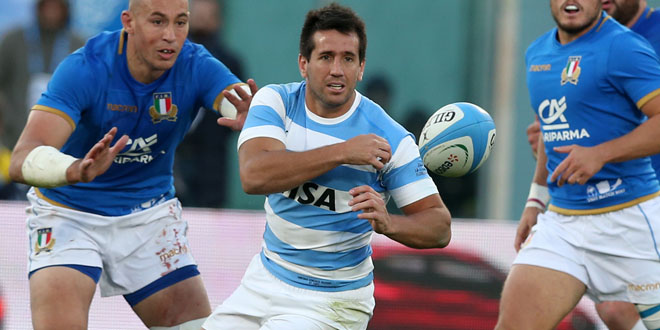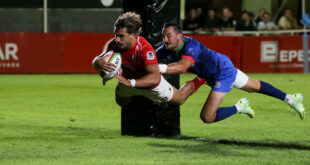Argentina’s struggles post RWC 2015 led to the downfall of Daniel Hourcade. The inability to win matches is well documented but what remains less commonly spoken about is the invisible leap from seasoned players to the test arena.
Invisible Leap
The invisible leap refers simply to a player learning his craft in an advanced setting which bridges his amateur training grounds to the elite level.
For years on end Argentina has benefited first hand from European clubs, most notably France and England. Consider Patricio Albacete, Marcos Ayerza, Marcelo Bosch, Manuel Carizza, Felipe Contepomi, Agustín Creevy, Ignacio Corleto, Juan Martín Fernández Lobbe, Juan Figallo, Omar Hasan, Juan Imhoff, Tomás Lavanini, Mario Ledesma, Gonzalo Longo, Agustín Pichot, Rodrigo Roncero, Nicolás Sánchez, Martín Scelzo, and Joaquín Tuculet.
These and many more featured heavily for Argentina in RWCs in the professional era. All spent long periods playing abroad, most doing so for many years and some in fact still play in Europe.
Los Jaguares was the home answer for the invisible leap. Yet it took many players who lacked prior experience playing abroad, often assuming the player was prepared for Super Rugby and Los Pumas. Many took over from seasoned players with little regard for whether they were of the same level. This saw many rapidly earning 20, 30 or more caps.
It was implemented following RWC 2015, a tournament which saw Argentina reach the Semi Finals. Daniel Hourcade believed there was a roster of players ready for Super Rugby and those same players would take Los Pumas into the 2016 Rugby Championship and on to RWC 2019 in Japan.
Ultimately it did not work out that way. The policy instead deprived Los Pumas of fielding the strongest team possible and culminated in Wales’ 2-0 series win this month in Argentina.
Recognizing the Misunderstanding
Hourcade’s 31-man roster that played in England and Wales in 2015 contained 21 UAR contracted players. That is to say, players who were to be Jaguares in the 2016 Super Rugby campaign.
Hourcade and the UAR were convinced that they were acting appropriately. Officially the line of reason was that some big names would remain in Europe but not many. Horacio Agulla, Marcos Ayerza and Juan Martín Fernández Lobbe retired from Los Pumas.
Remaining active were Marcelo Bosch, Juan Figallo, Mariano Galarza, and Juan Imhoff, a small number which does not sufficiently explain Los Pumas’ struggles since RWC 2015.
The misunderstood Pumas struggles stems from cutting off the source of Argentina’s production line. RWC 2007 was built on European clubs signing players and professionalizing them. 14 of the 15 who defeated France, Ireland, and Scotland, to get them to the Semi Finals, played abroad.
Los Jaguares have many players who have not had the same experience. Hourcade’s Pumas which were no match for Wales this month were entirely Jaguares. Of them six previously played in Europe over a sustained period – Agustín Creevy, Tomás Lavanini, Pablo Matera, Nicolás Sánchez, Leonardo Senatore, and Nahuel Tetaz Chaparro.
That is to say that the roster was entirely different to the one from RWC 2015. Since then Ramiro Herrera and Facundo Isa have returned to France, Santiago Cordero and Lucas Noguera Paz have gone to England and Nicolás Sánchez is leaving for France in November.
11 players that went to RWC 2015 had no experience in Europe prior to the tournament – Julián Montoya, Lucas Noguera Paz, Matías Alemanno, Guido Petti, Javier Ortega Desio, Tomás Cubelli, Martín Landajo, Santiago González Iglesias, Jerónimo de la Fuente, Matías Moroni, and Santiago Cordero. The remaining 22 players all did.
Hourcade selected the same 23 players for both 2018 matches against Wales. Of them 17 have never played abroad – Julián Montoya, Javier Díaz, Santiago Medrano, Matías Alemanno, Guido Petti, Marcos Kremer, Tomás Lezana, Javier Ortega Desio, Gonzalo Bertranou, Martín Landajo, Santiago González Iglesias, Jerónimo de la Fuente, Matías Orlando, Bautista Delguy, Sebastián Cancelliere, Ramiro Moyano, and Emiliano Bofelli.
Of the six who have one is Santiago García Botta who had a brief stint as a medical joker at Stade Français. The others are Agustín Creevy, Nahuel Tetaz Chaparro, Tomás Lavanini, Pablo Matera, and Nicolás Sánchez.
| RWC 2007 | 27 |
| RWC 2011 | 25 |
| RWC 2015 | 22 |
| June 2018 vs Wales | 6 |
Rushing of Players
Unlike in the prior three RWC tournaments the majority of Los Pumas are going straight from PladAR academies to the test arena. Has the rushing of players through the system directly impacted the performances of Argentina? Does this deprive Argentina of being at their best? The answer to both is yes.
Players are simply, in many cases, not ready for test rugby. Hourcade in fact admitted this himself, specifically noting that Argentina’s roster only has two sufficiently prepared props.
Javier Díaz and Santiago Medrano both debuted as replacement props against Wales. The series defeat was Hourcade’s downfall. As has been revealed Hourcade required two wins from the three home June Internationals against Wales and Scotland to keep his job.
The staunch policy on keeping out Europeans has hurt the team significantly. Crisis point is now and players are speaking. Both Patricio Albacete and Benjamín Urdapilleta agree that Los Pumas should have the best Argentine players regardless of where the play their rugby. Argentina is not New Zealand but the results from 2016-2018 can be learned upon. Learn from losing is a crucial part of sport.
 Americas Rugby News Rugby news from across the Americas!
Americas Rugby News Rugby news from across the Americas!




